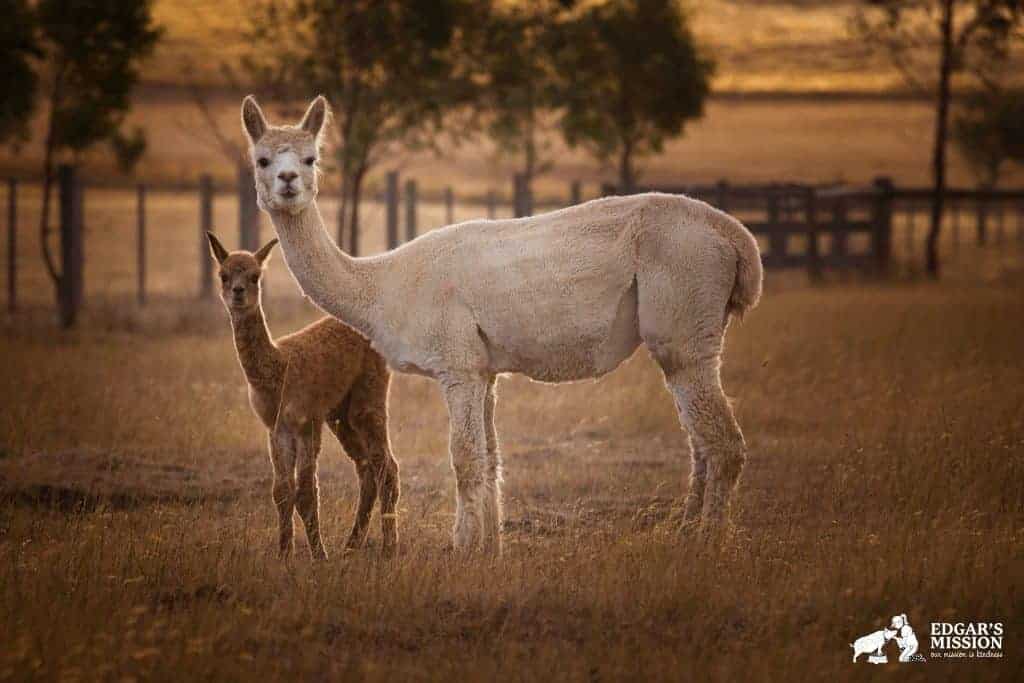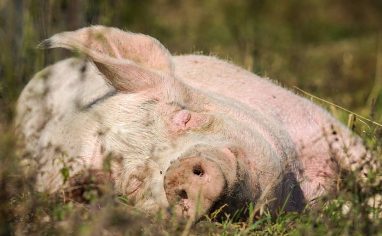

Veterinary Review Initiative
This resource has been reviewed for accuracy and clarity by a qualified Doctor of Veterinary Medicine with farmed animal sanctuaryAn animal sanctuary that primarily cares for rescued animals that were farmed by humans. experience as of August 2024.
Check out more information on our Veterinary Review Initiative here!
CriasYoung llamas or alpacas (baby alpacas and llamas) have their own special care needs to help them reach adulthood in good health and comfort. Depending on how old they are when they enter your care and whether they have had or continue to have access to their mother, crias have diverse needs when it comes to health, nutrition, and socialization.
Sanctuary Intake Recommendations For Crias
When a new criaA young llama or alpaca finds their way to your sanctuary, it’s critical to follow appropriate intake and quarantine guidelines in order to protect your new resident and the existing herd. The cria should be neutered (or spayed if this is part of your care protocols) if deemed appropriate by your veterinarian, receive all location-appropriate vaccinations, and should be tested for health issues. Depending on regional laws, you may also need to register guardianship of the cria with your local government.
Testing
Incoming crias, in particular, should be tested for Bovine Viral Diarrhea (BVD), as crias with persistent BVDV infection can spread the virus to others in their herd. However, testing for BVDV in nursing crias under 3 months of age may result in an inaccurate test result. Testing is done sequentially, with one test being followed by another after 3-4 weeks. Alpacas are generally more susceptible to BVD. While there are no specific camelid-approved vaccines, there are several for cowsWhile "cows" can be defined to refer exclusively to female cattle, at The Open Sanctuary Project we refer to domesticated cattle of all ages and sexes as "cows.", but there is a lack of data on their effectiveness and safety in camelids. Always speak with your veterinarian about the appropriate vaccines for your camelid residents.
Your veterinarian may recommend incoming crias be tested for Johne’s disease (after a certain age), tuberculosis, liver fluke, coccidia, or other infectious health issues based on their history and the regional location of your sanctuary. Work with your veterinarian to come up with a plan for infectious disease testing based on the cria’s age, health, and whether or not you know their mother’s health status.
Vaccinations
Always talk to your veterinarian about what vaccines they recommend, as the specifics of your region will influence what is best. Be sure your veterinarian fully understands your mission and how the sanctuary functions. There are certain vaccines that might be recommended to most of their clients but are not necessary for llamas and alpacas who will never breed or who spend most of their lives at the sanctuary rather than frequently going to exhibitions where they are exposed to many other animals with unknown backgrounds. There are not currently vaccines developed specifically for camelids, but your veterinarian may recommend off-labelThis term is often used to describe extra-label drug use. This means that a drug is used in a way other than what is described on the label or package insert. If a drug is used in a different species than what it has been approved for, this is extra-label use. Other examples include using a drug to treat a different condition than it is approved for or administering it in a different way than the directions describe. Extra-label drug use can only occur within the confines of a valid veterinarian-client-patient relationship. use of vaccines for certain clostridial diseases, tetanus, and rabies, among others. A clostridial 5-1, 6-1, 7-1, or 8-1 vaccination may be recommended based on resident health status and regional health concerns.
Neutering
While neutering is often considered more beneficial at an earlier age for many mammalian residents, male llamas and alpacas need more time for their musculoskeletal system to properly mature before castration. Llamas may be a little slower in maturing than alpacas. Because of this, it is generally recommended to wait until at least 18 months and up to 2 years before neutering any crias. Early castration can delay proper closure of the long bones of the legs in crias, causing luxating patellas and arthritis in the stifle joints. Of course, it is possible the cria may become capable of reproducing before this time and care must be taken to prevent breeding.
Prompt Healthcare
If they are with their mother, you should not separate the two unless absolutely necessary (especially if the cria is still nursing) such as if one of them has a communicable illness or needs extra space to recover from a health issue. Always weigh the stress of separation with the benefits. If separation is necessary or their mother dies, it is VITAL they have access to other alpacas/llamas in order to ensure they develop appropriate species behaviors, avoiding serious human safety and psychological issues later in their lives.
Upon intake, be sure to monitor the cria’s rectal temperature daily for fever and monitor joints and navel for any signs of heat, swelling, pain, or discharge twice a day. Typically, a cria’s temperature should be between 100 and 102 degrees Fahrenheit (37.8 to 38.9 degrees Celsius), but a healthy cria’s temperature can fluctuate due to environmental factors and activity level and could be higher without actually being a cause for concern. This is why it’s important to consider many factors when assessing a cria’s temperature- a cria who is bright and constantly playing who has a temperature of 103.5 is very different than a cria who has that same temperature but also has runny eyes, a cough, and doesn’t have a great appetite. Taking a cria’s temperature either in the morning and/or evening will likely give you the most accurate reading. After the first few days, assuming the cria appears healthy and has not been spiking a fever, you can take the cria’s temperature once a day instead of twice. If you have concerns regarding a cria’s temperature, always consult with your veterinarian and be prepared to give them other information about how the cria is doing overall (appetite, activity level, and if they have any other signs of concern).
- Normal Vitals
- Temperature : 100-102 degrees Fahrenheit (can be higher if the weather is hot or they have been particularly active)
- Respiratory Rate : 10-30 breaths per minute
- Heart Rate : 80-120 beats per minute
If the umbilical cord is still attached or the navel is still open, be sure to keep this area clean. Be sure they are in a clean living area with nice clean bedding to reduce the risk of infections. If the cria is over 7 days old, the navel and any remaining umbilical cord should be completely dry. The umbilical cord should be dipped or thoroughly sprayed to disinfect the area and encourage the umbilical cord to dry. There are a number of varying recommendations by veterinarians when it comes to solution dips for umbilical cords. You can speak with your veterinarian for their recommendation. It has been recommended you dip the umbilical cord in 7% povidone-iodine solution or a 2% chlorhexidine solution, then clean twice daily with dilute 0.5% chlorhexidine until healed. One study indicated that chlorhexidine offered the best protection against bacteria. It’s best to allow the umbilical cord to dry up and fall off on its own. If you have the capability to weigh the cria, this is a good idea and allows you to monitor for appropriate weight gain. From birth, alpaca crias should gain around one quarter to one half of a pound a day and llama crias should gain around one half to one full pound a day.
Immediate Treatment Required
If an incoming cria is showing symptoms of navel or joint ill (discussed in more detail below), or if they appear to have even the smallest limp in one of their legs, they must be hospitalized immediately and treated as these diseases can quickly cause irreversible damage and lead to sepsis which can be fatal.
Onsite Birth And Newborn Cria Care
Talk to your veterinarian about sanctuary birth and subsequent health plans for crias born onsite as there are a number of considerations to ensure a happy and healthy mother and cria. It is ideal to have a veterinarian or an expert present at the birth if possible or have the care staff trained on proper practices for providing newborn care and care for the mother before, during, and after birth. Alpacas and llamas generally have a gestation period of 11.5 months, though this can vary. Newborns are small, around 10-18 pounds (4.5-8 kilograms) for alpacas and 20-35 pounds (9-16 kilograms) for llamas. It is normal for a cria’s nostrils to flare a bit postbirth or even breathe open-mouthed for a brief period, but their breathing shouldn’t be overly labored (birth is hard on everyone so a little heavy breathing isn’t uncommon, but should regulate fairly soon after being birthed.) The cria should be up and standing by an hour or so after birth and walking, if clumsily, after two hours or so. It is important for the cria to bond with their mother during this time. Mothers and crias communicate through humming, nuzzling, and nose touching. Because they need colostrum, you will want to be sure they are nursing. They may nurse for a few seconds to a few minutes at a time. Close observation is important to ensure they are receiving the necessary nutrients. If time goes by and they haven’t successfully nursed or they appear weak, dull in appearance, or otherwise ill or injured, you may have to intervene. Your veterinarian may want to examine them immediately postbirth but, aside from this, they should be left to their bonding and just observed. Call your veterinarian immediately (if they are not already present) if the cria appears unwell. Crias should have their first bowel movement within the first 24 hours or so, often between 18-24 hours. If they don’t, contact your veterinarian as they may have an impaction and require veterinary assistance. Be sure to take measures to avoid hypothermia or hyperthermia in extreme weather conditions.
Food And Nutritional Recommendations For Crias
If The Cria Has Their Mother
If a cria came to your sanctuary along with their mother (or if a pregnant mother came to your sanctuary and gave birth), you should let their mother take charge of feeding and nutrition for the most part, as long as you are confident she is producing enough milk to do so. They will wean off of their mother’s milk when they feel it is appropriate, and as long as you have the appropriate solid foods and minerals available for when they make that decision, they will time their development much better than a human would in most circumstances! Both individuals will be much happier to have each other than if they had been separated.
The Importance Of Colostrum
With crias, nutritional care decisions hinge upon their precise age and whether they have received their mother’s (or a different recent mother’s) colostrum immediately after birth. Crias must ingest protective immunoglobulins through colostrum, the first milk produced by their mother when they are born. This substance also contains important nutrients and growth hormones that help the cria properly develop. Without colostrum, crias lack the crucial immune system boost required to help them survive and thrive until their own immune system develops. There is only about a 24-hour window for the cria’s intestinal lining to be able to absorb the colostrum’s antibodies, with the first 6 hours after birth being the most effective absorption time and an exponential loss in effectiveness as the day goes on. Crias born prematurely may not have adequately mature intestinal mucosal cells that allow proper absorption of colostrum. This means they will require immediate medical intervention.
If a cria does not receive adequate colostrum in the first crucial hours of their life, they must receive rapid medical intervention. If they are less than a day old, you should still try to administer actual or artificial colostrum, but once they’re more than a day old it is effectively useless. Use the mother’s colostrum if possible or frozen camelid or goat colostrum. If you do not know if the cria received colostrum, or do not know if they received enough, you can work with your veterinarian to test them for Failure of Passive Transfer (FPT). Crias who haven’t received colostrum should be provided rapid treatment including plasma transfusions, fluids, and possibly antibiotics administered in a clean veterinary environment. If this doesn’t happen for a cria who did not receive adequate colostrum, there is a very good chance they will not survive or will be prone to a life where they are always more susceptible to infectious diseases.
If A Cria Is Without Their Mother
If at all possible, a cria should nurse from their mother or adoptive mother. Without a mother present, you’ll have to feed a cria with a bottle or possibly through intubationthe introduction of a tube into a hollow organ (such as the esophagus or trachea), depending on the situation. Crias often don’t take to feeding from a bucket. Do not attempt to intubate without being properly trained by a veterinarian. If bottle-feeding, be sure not to hold the bottle up high. Instead, hold the bottle fairly level with their head to avoid aspiration.
Crias should be fed warmed pasteurized milk (Camelid or goat milk is ideal, though cowWhile "cow" can be defined to refer exclusively to female cattle, at The Open Sanctuary Project we refer to domesticated cattle of all ages and sexes as "cows." milk can also be used. Sheep milk is particularly high in fat and can cause diarrhea) or warmed kidA young goat milk formula (either should be typically heated to around 100 degrees Fahrenheit/37.8 degrees Celsius). The milk replacer will come with a scoop provided and all mixing instructions will be based on using that scoop, so don’t throw it out! Once you find a successful replacement, avoid jumping back and forth between formulas or different types of milk. Crias should be fed at least 10% of their body weight and up to 15%. Feeding too much milk replacer can cause nutritional diarrhea, so your veterinarian may suggest you stick with 10% body weight to prevent issues. If you took in a cria in the middle of this period of their life, try to get what they had been eating before coming to their new home so you can gradually transition their diet. This will prevent the likelihood of stomachaches or other digestive problems as their body adjusts. For particularly young crias, they will require frequent, even hourly, feedings. As they get stronger and older, you can reduce the number of feedings and increase the volume of each lesser feeding.
Calculating Milk Volume Based On Body Weight
1 Liter of milk or prepared milk replacer (mixed according to package instructions) weighs about 1kg. Starting with that knowledge makes calculating milk volume much easier. You can follow this formula:
| Steps | Example |
| Weigh cria | Cria weighs 22lbs |
| Convert weight to kg if weighing in lbs | 22/2.2= 10kg |
| Multiply weight in kg by percent you want to feed to get total amount per day | If feeding 10% body weight 10kg x 10% = 1L milk per day |
| Divide total amount fed per day by the number of meals to determine amount to feed at each meal | If feeding 4 times per day 1L/ 4 meals = 250ml (8.5oz) per feeding |
Now that you know the principles, you can use our free calculators below to sort out the math for you!
Bottle-Feeding Challenges
While not super common, staff should be aware of behavioral issues that may arise from overhandling crias. Much of what has been labeled berserk male syndrome or aberrant behavior syndrome is usually displays of misplaced territorial and social behaviors towards humans caused by overhandling crias (both male and female) and removing them from the company of other camelids where they would develop healthy relationships and learn normal camelid behaviors. Luckily, gentle, consistent training may help in situations where the behavior has been caused by overhandling and encouraging rough play behaviors. Some veterinarians now believe true aberrant behavior syndrome is caused by a brain tumor. In this case, gentle training is unlikely to be successful. The best bet is prevention. Do not remove the cria from their mothers unless absolutely necessary. Be sure they grow up with other camelids of their kind. Avoid overhandling and establish healthy boundaries surrounding personal space when engaging with a cria to discourage play behavior that can become dangerous to humans when these normal behaviors are applied abnormally towards humans as they get older.
If They Cannot Suckle
If a cria cannot take in food via bottle, artificial nipple, or bucket feeding (which is not usually successful), you may need to teach them how to suckle. Try seeing if they’ll suck on your finger, then carefully replacing your finger with the artificial nipple. It might take quite a few introductions until they get the hang of it! You can squeeze the nipple in order to get a bit of milk in their mouths to encourage suckling but use care to prevent aspiration. Do not enlarge the nipple size as this can lead to aspiration. If they are truly struggling with the concept, you may need to feed the cria via intubation until they learn so they continue to receive the vital nutrition they need to develop. Do not intubate anyone without receiving in-person training from an expert, as they can easily drown if not intubated exactly correctly every time. An injection of selenium may be given to crias who have a weak suckle response- contact your veterinarian for specific instructions.
Transitioning To Solid Foods
Many crias will begin at least nibbling grass or hay around 2 weeks of age, give or take a few days, and often wean themselves by 6 months. If a mother allows it, some crias may nurse longer, though in these cases, it is often more behavioral and less about actually needing milk. A mother may also choose to wean the cria herself earlier, around 4-5 months. So long as the cria has been successfully eating adequate forage for some time, this is usually okay. Some veterinarians may recommend adding alfalfa to a cria’s diet as a creep feed. It is a good idea to create a creep feeding area where only the cria can access forage and supplements. This will ensure they receive adequate nutrition and can help care staff better determine their intake, as adults won’t be able to access it. So long as there isn’t a health concern, mothers and crias should be observed and given space to wean on their own timeline.
Commercial feeds are not always required for healthy development. In fact, some youngsters show no interest at all and usually healthy adults with access to quality forage do not require concentrate supplementation. This is okay so long as they are gaining weight and appear active and healthy. While many adults do well on just good quality hay and grass, a soon-to-be mother may require grain as the energy requirements increase. This is true of a nursing mother as well. A SMALL amount of supplemental commercial food can be offered to crias, especially if they are observed trying to nibble some of their mother’s. But it isn’t a cause for concern if they don’t seem interested and they are developing healthily. Commercial formulas for mothers (“hembras”) and crias are available. Speak to your veterinarian about the recommended amount of supplemental commercial foods for your cria resident.
NEVER use commercial food developed for ruminants, as some contain antibiotics that are toxic to camelids. Be sure to observe the cria eating any pellets, as choking is a risk if they consume them too quickly. If a cria is eating commercial foods, it is recommended by some veterinarians that they first are vaccinated for enterotoxemia (Clostridium perfringens D). Copper toxicity is also an issue, and care must be taken to avoid excessive amounts of copper in the diet. Because of this, camelids should not have access to mineral salt blocks or loose mineral mixes if they are eating a pelleted food unless they contain no copper and you have spoken to your veterinarian. In these cases, your veterinarian may recommend you simply provide loose salt without minerals if they are receiving adequate amounts from their food. A soil test can be helpful in determining the presence and amounts of minerals in grass and plants which can help create a fuller picture, allowing you and your veterinarian to make the best decisions about mineral supplementation at your sanctuary.
Your veterinarian may want to provide additional supplementation, such as Vitamin D or Selenium. Talk to your veterinarian about any diet-related questions you may have to ensure the cria is receiving the proper nutrition.
Living Space Recommendations For Crias
It’s important to ensure that crias are provided with relief from extreme temperatures. In colder environments, they may require extra bedding in the form of straw, or safe heaters, or coats or blankets, until they’ve developed more robust coats and extra insulating body fat. In hot environments, it’s important to give them ample opportunities to avoid overheating, including employing gentle misting fans (making sure not to get their environment too moist) and giving them ample shade if they desire it. You may also want to provide both indoor and outdoor living spaces separate from other adults in the herd (other than their mother if she’s present) to keep them safe until they grow a little bigger and stronger, and until their immune system grows more robust. However, if they arrive as orphans, it is important they have as much safe contact with other camelid residents of their kind as possible in order for them to learn appropriate behavior. Another female resident may act as a surrogate mother, especially if they have recently lost their own cria. Once they can graze on pasture or hay exclusively, they’ll usually be ready to handle being with other camelids of their kind. Be sure to provide llama and alpaca crias with enriching opportunities as well!
Social Recommendations For Crias
While it is crucial for their development to spend their time with other camelids of their kind, crias may need to be given space away from mature alpacas/llamas (except for their mother or a surrogate mother) until they have matured to a point where they no longer require supplemental feeding. At this point in their development, they’ll be strong and nimble enough to spend time among their herd and will have the ability to safely get away from others if confronted or bullied. When you first introduce a much younger cria to the existing herd, make sure to watch over initial interactions to ensure everyone is playing safe. It’s unlikely for there to be many problems, but every alpaca/llama has their own personality and some might be more rambunctious or hesitant to bond than others. Older alpacas and llamas will teach a younger one how to appropriately play and establish boundaries. If you are caring for multiple new crias together, once they are given a clean bill of health from a veterinarian, they will typically make for very close lifelong companions with few attitude problems!
Common Cria Health Challenges
While not an exhaustive list of the potential health challenges a cria could face, below are the most common issues that affect crias.
Bovine Virus Diarrhea
BVD is a contagious viral infection caused by Bovine Viral Diarrhea Virus (BVDV). While cows are the natural host for this virus, camelids, and other species can be affected too. Though the name suggests gastrointestinal disease, BVDV can affect multiple body systems, resulting in respiratory, reproductive, circulatory, musculoskeletal, immune, organ, or neurological health challenges as well as gastrointestinal issues. Symptoms may include fever, diarrhea, mouth sores, anorexia, abortion, birth defects, and ill thrift. BVDV can cause subclinical disease or acute illness, but the most concerning characteristic of this virus is its ability to create persistently infected (PI) individuals. Crias are often persistent infection individuals and a common cause of herd infections. They are infected as fetuses and shed the disease after birth, spreading it to other individuals. Afflicted crias may have symptoms or appear perfectly healthy. Those who are acutely infected with BVDV may be asymptomatic, but the infection causes immunosuppression, putting them at risk of developing other infections. There is no treatment for BVDV infection, but depending on the severity and clinical signs, individuals may require supportive care and broad-spectrum antibiotics to prevent secondary bacterial infections. While there are vaccines for cows, both live and inactivated vaccines, they are not currently recommended for camelid species due to a lack of data on safety and efficacy. Learn more about BVD with our resource here.
Clostridial Diseases
While there are a number of clostridial-related diseases, llamas and alpacas are only susceptible to some of them. Clostridium perfringens A, C,and D, Clostridium tetani (tetanus), C. novyi and C. haemolyticum, and C. septicum are some of these. Of these, some may only be of concern if you live in certain regions. As mentioned above, there are off-label vaccinations available. There are different vaccination schedules recommended for mothers and crias, so speak with your vet about the best schedule in each individual’s case. A cria can receive some protection if their mother had a vaccination within a certain timeframe before they were born, assuming they nurse successfully in the hours following birth, but they will need to be vaccinated as well. Prevention is important as clostridial-related diseases can cause serious, life-threatening illnesses. Some types cause severe diarrhea and gastrointestinal issues, central nervous system issues, while the only sign of infection in others is sudden death.
Coccidiosis
Coccidia are protozoans that can damage an alpaca or llamas small intestinal lining. Most adults are infected and immune, but crias are at risk of fatal infestations. An acute infection can lead to anemiaAnemia is a condition in which you don't have enough healthy red blood cells to carry adequate oxygen to the body's tissues., dehydration, fever, hair loss, weight loss, stunted growth, and bloody, mucus-filled diarrhea. Usually, coccidiosis is a result of overcrowding, stress, and poor sanitation. The best prevention is keeping their living spaceThe indoor or outdoor area where an animal resident lives, eats, and rests., the indoor or outdoor area where a resident lives, eats, and rests, clean and uncrowded! There are medicines available to treat infections. As a preventative measure, you should have a lab perform a fecal test every three months to ensure that they are not facing a dangerous parasitic infection.
Congenital Abnormalities
Compared to other resident species, alpacas and llamas tend to present more frequently with congenital abnormalities. Some of these are essentially harmless while others require immediate treatment. Some are sadly fatal. Limb abnormalities, heart defects, urogenital, and facial abnormalities are some of the more common possible congenital issues. If you are taking in a young cria with an unknown health history or expecting a new resident cria to be born, familiarizing yourself with some of the more common abnormalities can help you know what to look for and when to call your veterinarian for assistance. Here we will briefly cover a few of these impairments:
- Choanal Atresia : Choanal Atresia refers to a narrowing of the back of the sinuses that can make breathing difficult for the cria. One or both of the sinuses may be narrowed and the extent of the narrowing can vary. For a cria trying to suckle, this can present a serious issue as they try to breathe and suckle simultaneously. If you notice a cria open-mouthed breathing (beyond a short time after birth), you need to call your veterinarian as soon as possible to learn the extent of the narrowing and discuss possible treatment plans.
- Atresia Ani or Recti or Coli : Atresia ani is the absence of an anus. There may be a slight bulge where the anal opening should be. Obviously, this requires immediate veterinary care as the veterinarian will need to perform surgery as soon as possible. Atresia recti or coli can be more difficult to identify and correct. This is where there is a stricture in the rectum or colon. In all cases, straining to defecate and abdominal distension are the primary signs. Euthanasia may be recommended in severe cases of atresia recti or coli if surgery isn’t an option.
- Atresia Vulvi : In atresia vulvi, the labia are partially or completely fused. As urine accumulates, a bulge will form below the anus. If it is a partial fusion, urine may be released in a small stream. Both require immediate veterinary attention. The veterinarian will likely perform a surgery correcting the issue.
- Umbilical Hernias : Umbilical hernias are common in llamas and alpacas. Often, smaller hernias can be reduced without surgery, but larger hernias often require surgical intervention. If you notice signs of swelling or a mass, it may be indicative of an umbilical hernia. A veterinarian should be called to determine the size of the hernia as well as whether there is infection present.
- Ventricular Septal Defects : VSDs are one of the most common congenital heart malformations in camelids. Often camelids with VSDs will also have another heart defect as well. Luckily, many VSDs are small and located in areas that still allow for healthy functioning. Small VSDs in crias may even close themselves without veterinary intervention. Larger VSDs or those located in critical areas may cause heart failure. Signs include excessive recumbencyRecumbency is the state of leaning, resting, or reclining., open-mouthed breathing and recumbency after physical activity, and heart failure. Sometimes these defects can be diagnosed through simply listening to heart sounds, while others require diagnostic testing.
Contagious Ecthyma (Sore Mouth, Orf)
Sore mouth is a viral disease caused by a relative of the chickenpox viral family. It enters an individual through cuts or abrasions of their skin (or through nursing in crias) and is highly contagious in both camelids and humans. Sore mouth symptoms include blisters in less hairy parts of their body, on their lips and mouth, with the blisters eventually becoming scabs. It is especially dangerous in crias, who may not be able to properly nurse when infected and can quickly become malnourished. It runs its course in three to four weeks. Afflicted crias should be isolated during the course of symptoms. Treatment involves applying approved medicated ointments to sores and thoroughly cleaning anywhere where the affected cria had been spending time. It’s important to ensure that the sores do not develop secondary bacterial infections. Crias can be carriers of the disease (and spread it to other camelids) without ever showing symptoms, and once a cria has had sore mouth, they are unlikely to ever become symptomatic again (similarly to humans and chickenpox).
Diarrhea
Diarrhea is commonly seen in crias. While there are a number of different causes, infectious types are the most common, including viral, bacterial, and parasitic infections. Diarrhea can also be seen in bottle-fed crias who are being overfed and in crias who have been treated with antibiotics, though diarrhea is more often from an infectious source. Newborns, particularly those who did not receive adequate colostrum, are especially vulnerable to infections. It is important to identify the cause in order to properly treat the issue. Causes of diarrhea in crias include coronavirus, cryptosporidium, giardia, BVD, rotavirus, and coccidiosis. If a resident has diarrhea, it is vital to call your veterinarian and determine the cause in order to start the correct treatment. Depending on the cause, the cria may require electrolyte replacement and other supportive care, as well as medication to treat the underlying cause.
Failure Of Passive Transfer Of Immunity (FPT)
FPT happens when a cria doesn’t receive adequate colostrum in the 24 hours following birth. The first 6 hours is a crucial time for nursing, as this is when the most colostrum is available. The available colostrum will steadily decrease over the first 24 hours and the ability of a cria’s intestinal lining to absorb colostrum will decrease as well. When this happens, crias are prone to infections of all kinds (bacterial, viral, parasitic) and must be carefully observed for any signs. They must be cared for in a clean environment and exposure to possible infectious agents must be limited. It is common for crias with FPT to develop infections and septicemia (sepsis), which can spread to systems throughout the body and lead to death in many cases. If a cria presents with issues such as joint ill or navel ill, they should also be checked for other concurrent infections or sepsis. Any signs of illness should immediately be reported to your veterinarian so treatment can begin as soon as possible. Often, sepsis is seen in crias with infections less than a week old.
“Floppy” Syndrome
“Floppy” syndrome is a term used to refer to premature camelids whose cartilage has not fully matured. This manifests as “floppy ears”, an inability to hold their head up, get up, or even maintain sternal recumbency. Their coat will appear silky and their incisors will not have erupted, which will make suckling difficult. In addition to these symptoms, they will have poor muscle tone and lax tendons, causing hyperextension of their limbs.
Hypothermia
Newborns are especially susceptible to hypothermia, particularly if born at night or in cooler seasons. When they are born, the external temperature drops so much that hypothermia becomes a risk. Be sure they are protected from the weather and drafts and be sure they are dried off. Provide a safe external heat source such as hot water bottles, warmed blankets, or other heat sources such as radiant heaters. Check out our fire safety resource on safe sources of heat. It is important that the cria is protected from direct heat sources and is not subjected to excessive heat, as this can cause further health issues. Although initially a bigger expense, a Bair-hugger warming device is used in some veterinary hospitals, as is the HotDog warming device. You can speak with your veterinarian to see if these may be a good option for crias or other residents in danger of hypothermia. Providing a coat for the first day or two (or more if recommended by your vet) can give the cria time to acclimate. NEVER put a blanket or coat on a resident who is wet. In addition to a typical coat, there are also neck warmer coats available for purchase. You can also make a temporary neck warmer from an old sweater or sweatshirt. Don’t be overzealous though. If they aren’t showing signs of hypothermia and the weather is fairly mild, you won’t need to provide a coat. If a newborn or even older cria appears lethargic and depressed, is shivering, and/or has a low body temperature, they may be hypothermic.
Johne’s Disease
Also known as paratuberculosis, Johne’s disease is a fatal contagious gastrointestinal disease caused by the bacteria Mycobacterium avium subspecies paratuberculosis (MAP). It is believed that all species of ruminants and camelids are susceptible to this infection, with young individuals being most vulnerable. The primary mode of transmission is the fecal-oral route, but it can also be transmitted via colostrum and milk. For more information about this challenging disease, including information regarding diagnostics and ways to mitigate disease spread, check out our full resource on Johne’s disease here.
Joint Ill
While less common in camelids, septic arthritis can occur in crias and is always a serious matter. Crias with FPT are at an increased risk of this. If you notice signs of lameness such as favoring a leg or limping, check for heat and swelling of the joints, and signs of pain. Call your veterinarian immediately, as this requires immediate treatment. Your veterinarian will likely prescribe different antibiotics and possibly perform a joint lavage to rid the infection. Ignoring the signs can lead to permanent impairment and even death.
Meconium Impaction
Crias should pass their first poop (meconium) within the first 24 hours of birth. A healthy active newborn may pass meconium as early as 6 hours after birth. The consistency will vary from cria to cria, with stringy or pasty dark or tan poop being normal. If you notice a cria straining, squatting, or wagging their tail and there is no sign of stool, this could indicate an impaction. Their abdomen may be distended, causing discomfort. Your veterinarian will likely prescribe an enema. They may use different preparations and it is important to not attempt this yourself if you haven’t been properly trained and advised by a vet, as complications can occur and impaction can also be a sign of an underlying condition that requires veterinary intervention.
Navel Ill (Umbilical Infections)
Crias with FTP, especially those born into dirty environments and who do not receive proper navel (umbilical) treatment, are especially prone to navel infection, referred to as navel ill or Omphalitis. While Infections of the navel are less common in crias than in calves, they can still occur. In newborns, the umbilicus, or navel, is open and can allow bacteria to enter. The umbilical cord serves as a connection between the cria and mother for the transfer of nutrients, and after being born this membrane is torn and should dry up and close within a few days of birth. Crias with navel ill may have hot, swollen, painful navels, there may be discharge present, and the cria may appear depressed, lethargic, show signs of colic, or have little interest in eating. Maggots can also develop in this region if there is an infection present. This is generally noted about 2-5 days after birth. Left untreated, the infection can spread resulting in other issues such as peritonitis, joint ill (described below), or septicemia. Crias with suspected navel ill should be assessed by a veterinarian immediately and will require systemic antibiotic treatment, possibly intravenously. In some cases, surgical intervention is also necessary. Be sure to keep cria living spaces clean and dry, monitor their navel twice daily, and follow the instructions listed above regarding proper navel care and rectal temperature monitoring.
Growing Up
As crias reach maturity, they may begin to display behaviors previously unseen in their own behavioral repertoire. You may notice changing social dynamics between them and other residents in their herd. Some may become territorial. While this is seen more in males, it certainly can be seen in females as well. Crias who have been overhandled and have imprinted upon humans may begin to treat the humans around them as though they are also an alpaca or llama. At times, certain humans may become the focus of undesirable attention such as charging, chest butting, and biting. Humans have been seriously injured by camelids that have been reared by humans. Do not take this personally, but do take it seriously. Prevention is the best bet. Maintain appropriate social boundaries when caring for crias. Remember, growing up with others of their kind is an important part of their lives that will affect their relationships with other camelids and humans in the future.
Cria Milk Volume Calculators
To help calculate the volume of milk you might need to feed crias per meal, we’ve developed a calculator (both in pounds and kilograms) for your use!
- Cria Milk Volume Calculator (In lb)
- Cria Milk Volume Calculator (In kg)
SOURCES
Alpacas And Llamas (And Other Camelids): Standard Operating Procedure | Queensland Schools Animal Ethics Committee (Non-Compassionate Source)
Alpaca Medicine Part Two: Practical Points | Vet Times (Non-Compassionate Source)
Camelid Castration | Ohio State University (Non-Compassionate Source)
Camelid Surgery | Llamas And Alpacas In Veterinary Practice (Non-Compassionate Source)
Routine Camelid Procedures – Part 1: Castration Of Alpacas And Llamas | Veterinary Meeting And Expo: 12th Proceedings (Non-Compassionate Source)
Medicine And Surgery Of Camelids Third Edition (Non-Compassionate Source)
Bovine Viral Diarrhea Virus In Camelids | Washington State University (Non-Compassionate Source)
Disease Of Llamas And Alpacas | The Merck Veterinary Manual (Non-Compassionate Source)
An Introduction To Diseases Of Alpacas In Australia | Flock & Herd (Non-Compassionate Source)
Vaccinations in Camelids | Colorado State University Veterinary Extension
5-In-1 Clostridial Vaccination Of Alpacas | Criagenesis (Non-Compassionate Source)
Camelid Herd Health | Veterinary Clinics: Food Animal Practice (Non-Compassionate Source)
Preventing Navel Ill | Washinton State University Agricultural Extension (Non-Compassionate Source)
Supplementing Crias With Milk | Criagenesis (Non-Compassionate Source)
Lactation And Neonatal Care | Llama Alpaca Care (Non-Compassionate Source)
Basics Of Alpaca Nutrition | Alpaca Research Foundation
Management Of Llamas And Alpacas | Merck Veterinary Manual (Non-Compassionate Source)
Neonatal Diseases In Llamas And Alpacas | Veterinary Clinics Of North America: Food Animal Practice (Non-Compassionate Source)
Congenital And Inherited Anomalies Of The Small And Large Intestine | The Merck Veterinary Manual (Non-Compassionate Source)
Viral Diseases of New World Camelids | Veterinary Clinics: Food Animal Practice (Non-Compassionate Source)
Cryptosporidium Parvum As A Risk Factor Of Diarrhea Occurrence In Neonatal Alpacas In Peru | Parasitology Research (Non-Compassionate Source)
Diseases Of The Cardiovascular And Hemolymphatic Systems | Llama And Alpaca Care (Non-Compassionate Source)
Chapter 60 – Urogenital Surgery In Camelids | Llama And Alpaca Care (Non-Compassionate Source)
Non-Compassionate Source?
If a source includes the (Non-Compassionate Source) tag, it means that we do not endorse that particular source’s views about animals, even if some of their insights are valuable from a care perspective. See a more detailed explanation here.






